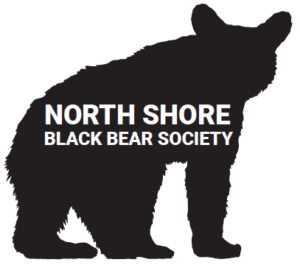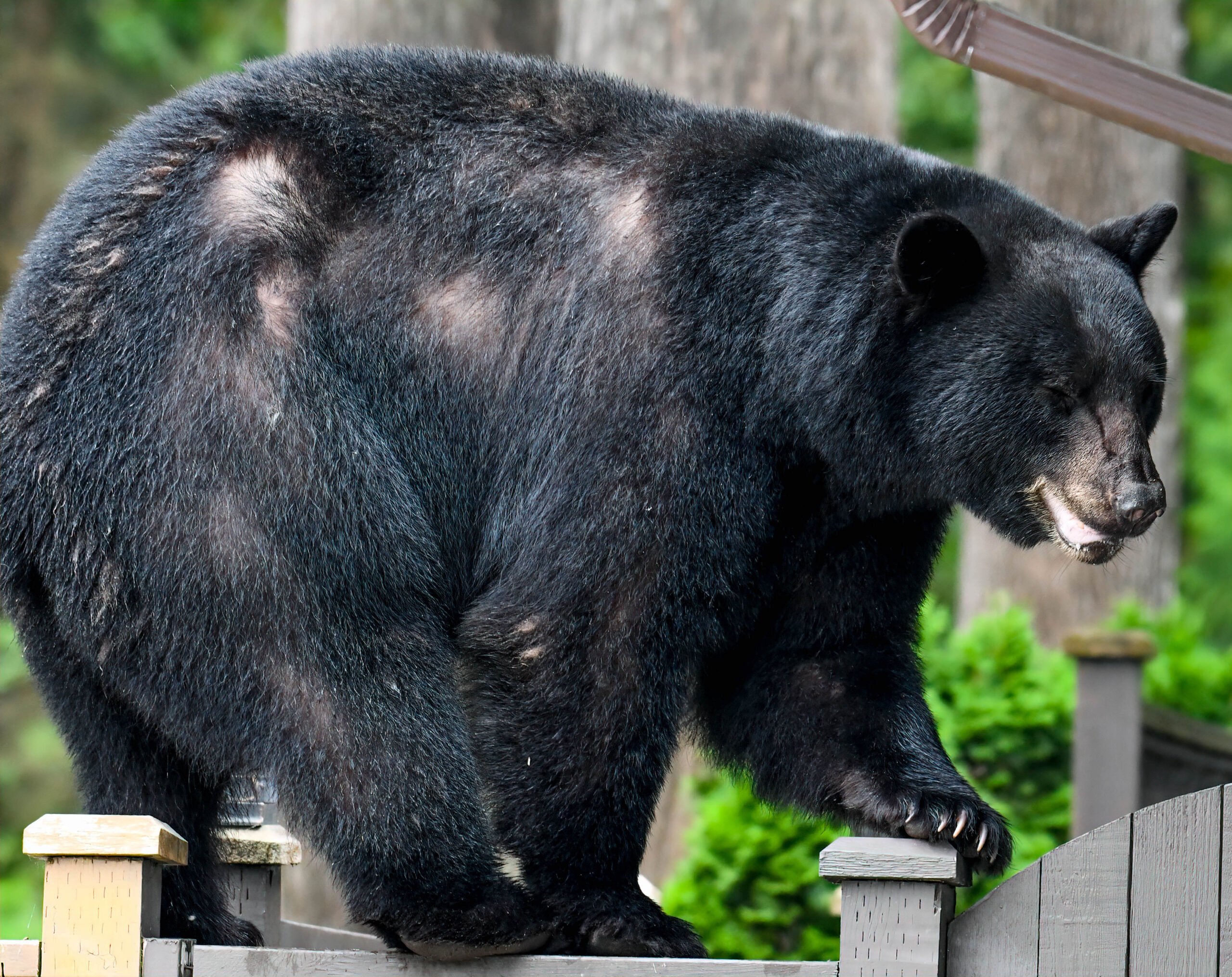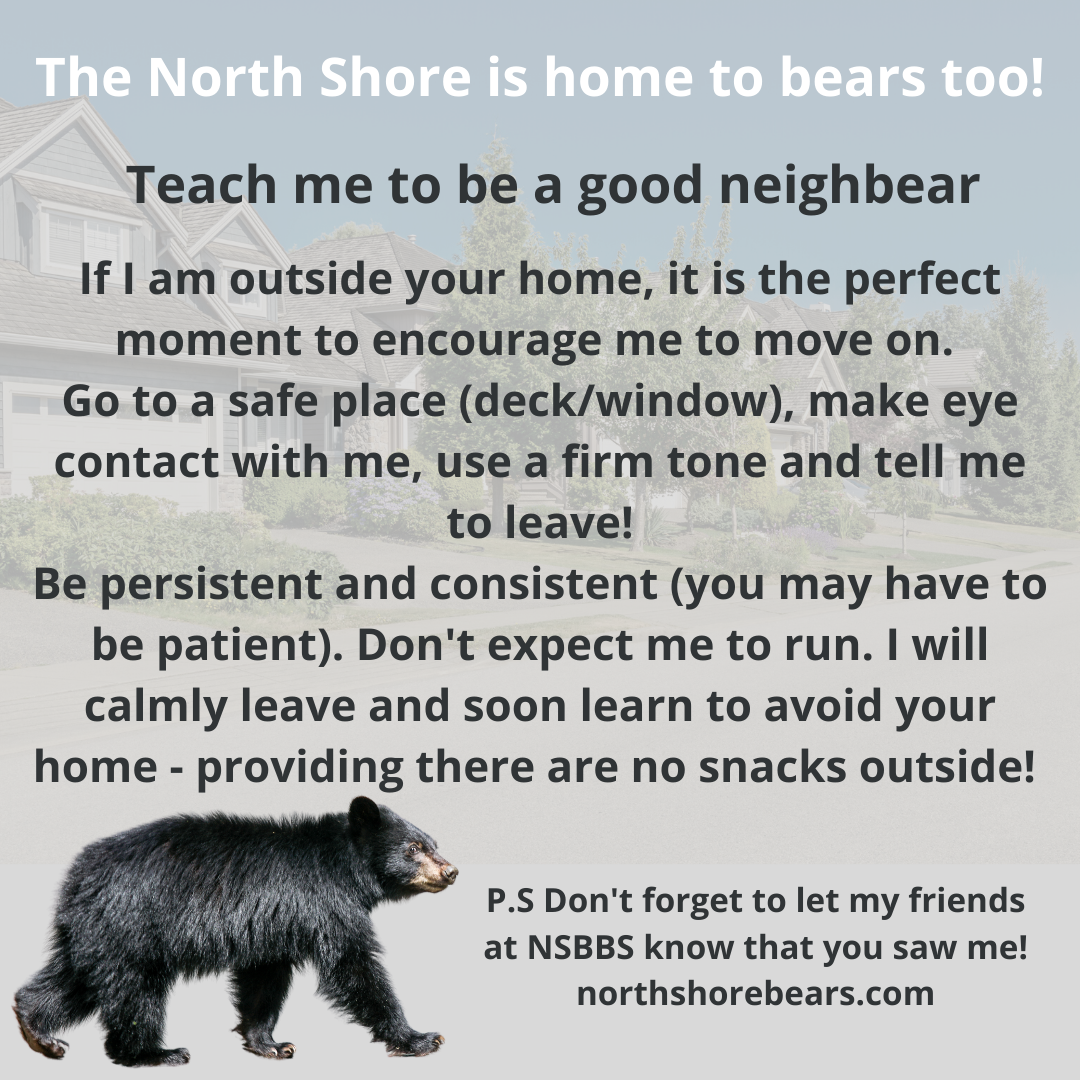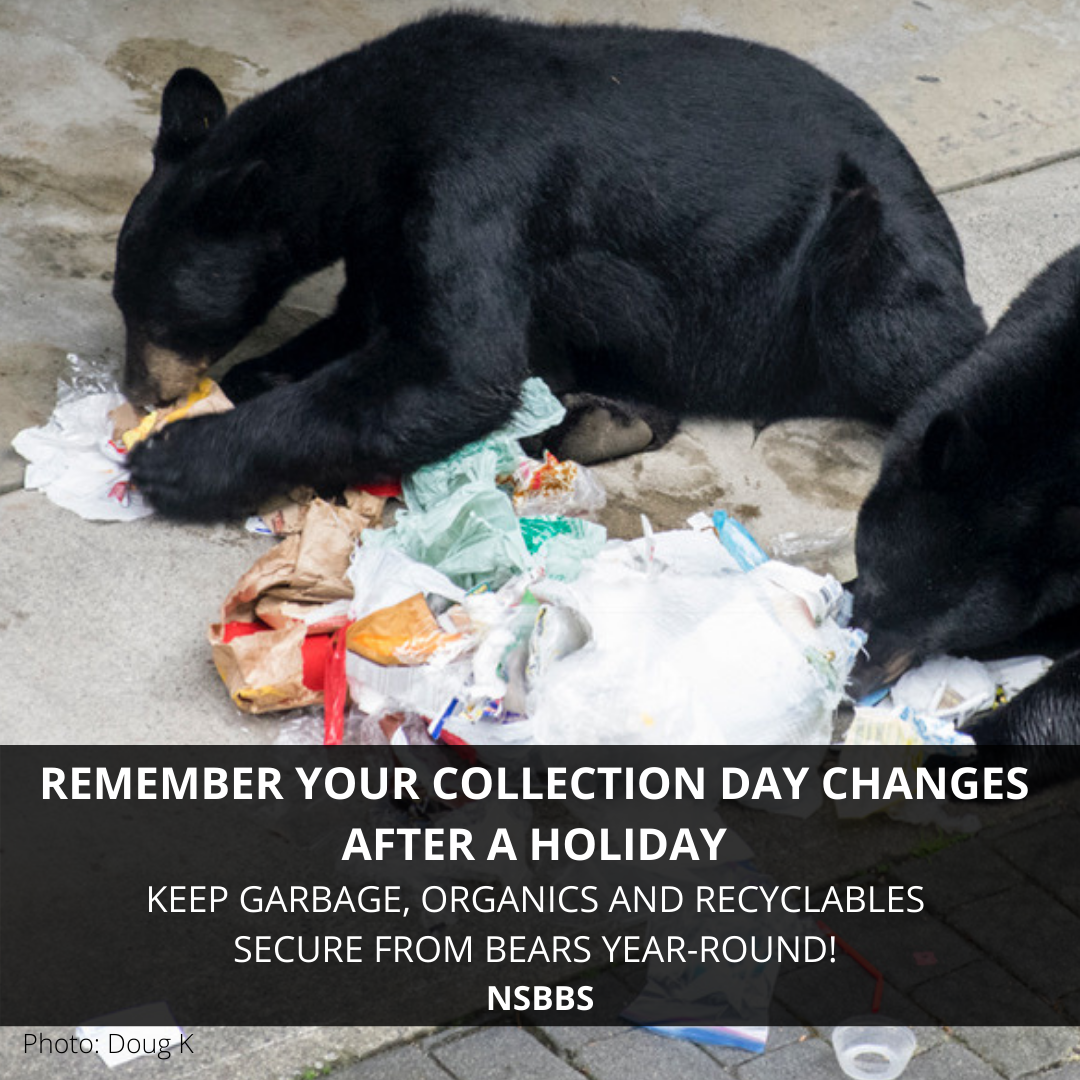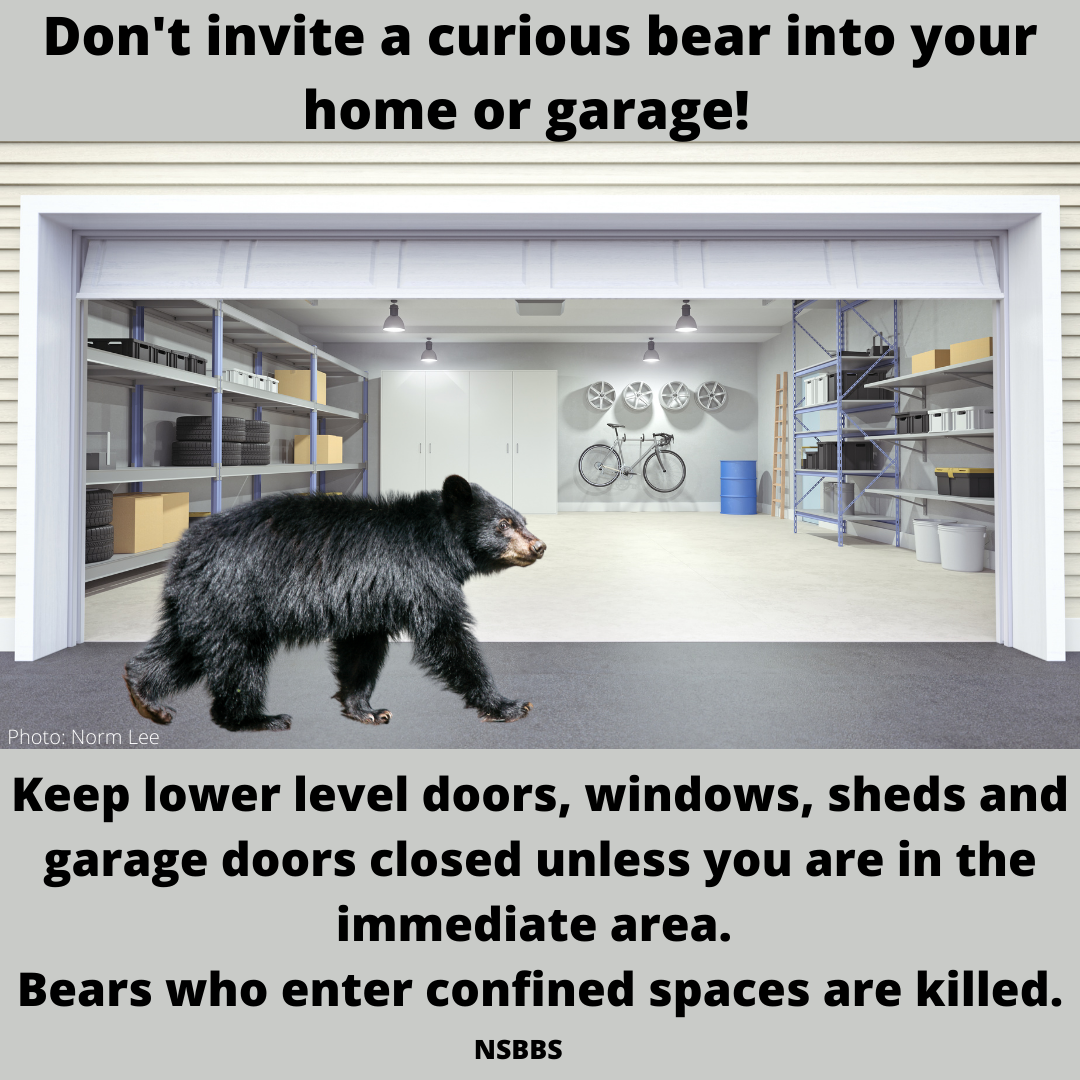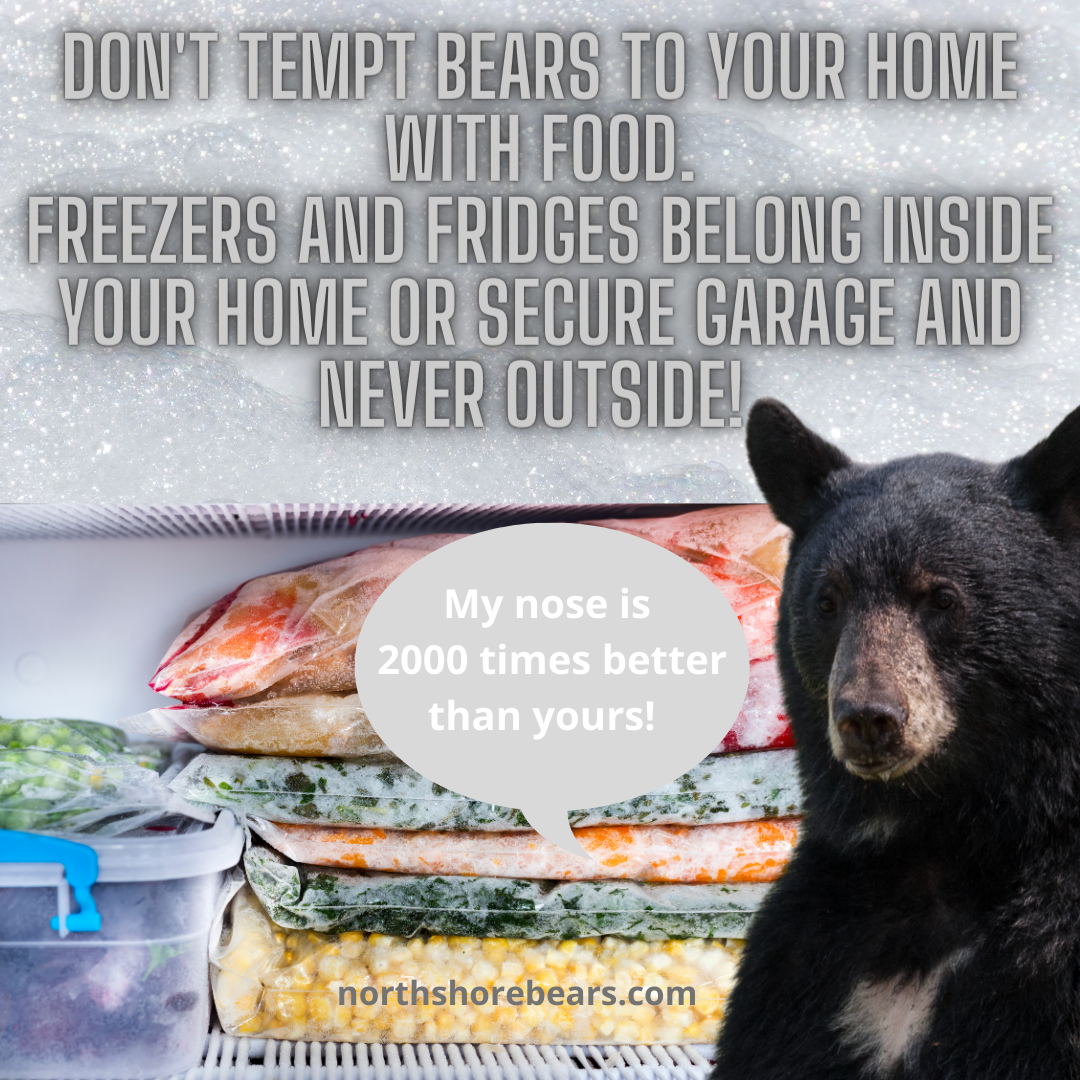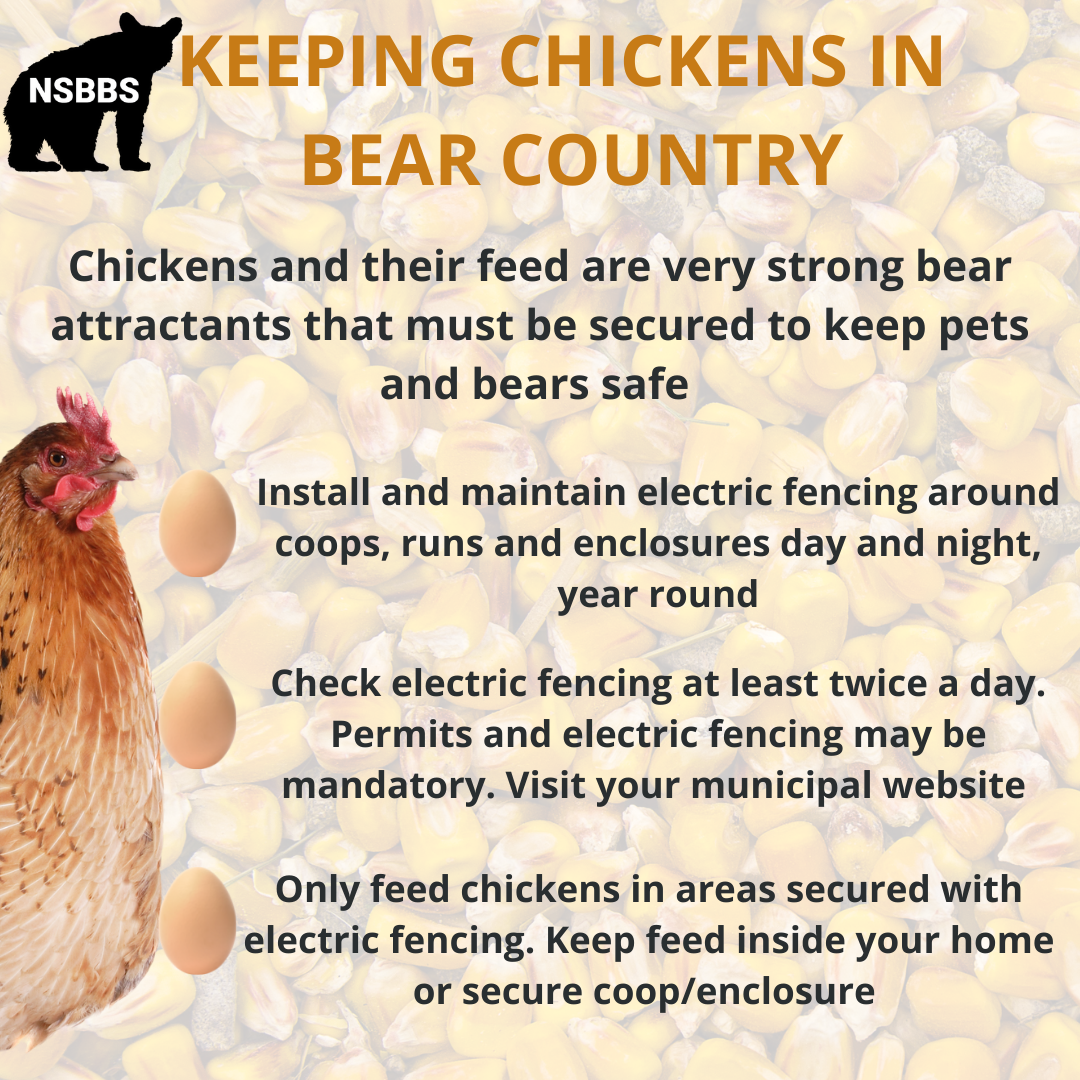LIVING IN BEAR COUNTRY

We share the North Shore with black bears. Responsible coexistence with these peaceful animals is possible if we learn more about their reasons for being in urban areas, act on ways to reduce attracting bears to our homes and set boundaries from a safe place if bears are on our property.
From sea to sky, we live in bear country. Black bears can be found anywhere on the North Shore, at any time of day or year. Access to unnatural foods from humans contributes to a shorter denning season for our black bears. North Shore bears are expanding their range, and sightings in Central and Lower Lonsdale – communities where sightings were rare up until 2019 – are becoming more frequent.
Given the beautiful nature of where we live, it is normal for bears to pass through neighbourhoods as they travel along creeks, rivers and green spaces in search of food and safety. Bears are commonly reported eating natural food in residential areas and vulnerable bears occupy areas closer to us for safety from dominant bears. Bears that find food from people spend more time in urban areas where they are at risk of being killed by the BC Conservation Officer Service and vehicles. Every year on the North Shore, bears are shot for finding food from people. Relocation is rarely an option, and it cannot be the solution. When a bear is removed from a location, another will soon take their place. In many cases when bears have been killed by BCCOS, another bear was in the area within days. Bears regularly spend time in areas close to people without incident, however, efforts must be made to ensure we don’t invite bears to make themselves at home in residential areas.
COMMON ATTRACTANTS
With a few simple actions, we can dramatically reduce a bear’s reason for staying in the neighbourhood. Unnatural food sources contribute to late winter activity from bears across the North Shore. We strongly advise managing bear attractants on your property year-round. Garbage, organics, bird feeders and fruit trees are the most commonly reported bear attractants. Here are some preventative practices to make your home less appealing to black bears:
GARBAGE AND ORGANICS
Garbage and organics are the most commonly reported bear attractants, contributing to countless human-caused bear deaths and increased bear activity in residential areas. Bears are curious and intelligent animals who are led by their noses. Making efforts to reduce odour and securing highly odorous items will go a long way to reduce tempting a bear to your home.
- Keep garbage and organics in a secure area at all times, unless out for collection. Store these items inside your home, secure garage or secure shed/enclosure. The District of North Vancouver issued lockable carts are not bear-proof and should be stored in a secure area.
- If you have a carport, invest in a secure enclosure or use bungee cords to attach carts to a strong structure to prevent them from being tipped, which is how bears typically access those carts. Extra efforts must be made to reduce odour. Keep both locks secure at all times when carts are on your property.
- Freeze meats, fats, grease, fish, bones, and eggshells which are strong attractants and as many other food scraps as possible. Add these frozen items to your organics waste on the morning of collection only.
- Used diapers are a strong bear attractant and should be kept inside your home or secure garage or enclosure until collection morning.
- Bears may be more persistent at attempting to seek out odorous items such as diapers, meat, fish, bones and grease. Be sure that enclosures are secure and locked at all times.
- Wrap food scraps in newspaper or brown paper bags to contain odour and keep carts clean.
- Regularly wash garbage and organics carts with a water and vinegar solution.
- If a bear finds food (including garbage) at your home, they will return. Clean carts thoroughly and keep them empty for as long as possible. After a few unrewarded visits, the bear will learn there is nothing for them at your home.
- No items are permitted at curbside overnight. Garbage, organics and recycling must remain securely on your property until the morning of collection, as per bylaw in all three North Shore municipalities. Visit your municipal website for specific set-out instructions, to download your collection schedule app and request cart repair (DNV residents).
BIRD FEEDERS
Bird seed and suet are highly sought-after food for a bear. Bird seed is nutritious and contains fats, oils and proteins that are incredibly enticing to bears. Hummingbird feeders are sugary energy drinks and bears love them.
- We strongly advise residents of bear country not to hang bird feeders, year-round.
- Black bears will climb onto a second-floor deck or roof of a house for the high calories a bird feeder provides. They are agile climbers with a long reach; bird feeders must be suspended 10ft from the ground and any access points (tree, fence, building).
- Bears are active during the day: taking your bird feeder in at night is not the solution, and on the occasion you forget, be sure the bear will find it.
- Bears can easily sniff out scattered seed or nuts. If you want to feed birds, please only place a very small amount of seed on a plate when you are outside to enjoy them.
- Please consider these alternatives to encourage birds to your garden: plant with birds in mind, install bird baths, sand boxes or nesting boxes. A bear may drink from your bird bath as they travel through the neighbourhood but we do not consider them attractants.
FRUIT TREES
Fruit is highly attractive to bears and unmanaged fruit trees contribute to frequent bear activity in neighbourhoods. Bears have excellent memories, especially in relation to food, they will return to the reliable, juicy rewards of a fruit tree for years.
- Bears love all fruits and berries. Please refrain from planting fruit bearing plants, unless you can commit to managing them.
- Prune fruit trees so they produce less and better quality fruit. Remember that fruit from all heights of the tree will need to be harvested each season. Bears are agile tree climbers with a long reach.
- Pick all berries and fruit just before they ripen. Allow to ripen inside your home or secure garage.
- Collect all fallen fruit daily and store in a secure area. Fallen fruit is highly odorous and attractive to bears and rodents.
- Install and maintain electric fencing to protect your fruit trees, ensuring there are no access points the bear can reach from. Be sure to check the fence at least twice a day.
- Please consider removing fruit trees if you do not use the fruit or have the time to manage them.
AVOID INVITING A BEAR INSIDE YOUR HOME OR GARAGE
Curious bears may enter through an open door, screen or open garage in search of food or shelter. Bears who enter confined spaces are almost always killed. Be sure to keep doors closed at all times, unless you are in the immediate area. It is rare for a bear to enter a confined space if people are in the immediate area. Make sure garage doors are study and fully secured if you are not right outside. If you encounter a bear in your home or garage: speak to the bear in a calm voice as you slowly move away to a safe place. Make sure the bear has an exit. From your safe place, use a firm, harsh tone to try to encourage the bear to leave. Aim to go to an area where you can observe the bear leaving. If the bear has received a food reward, expect them to be back and make extra efforts to secure food and doors around your home.
TEACHING BEARS
Bears are intelligent animals and they can be taught to avoid areas where they shouldn’t be. It is important to set clear and consistent boundaries with bears by ensuring there is no food inviting them and by moving them on from a safe place if they are on your property. Bears are becoming accustomed to loud noises such as air horns, barking dogs, pots and pans and car alarms. Whilst those noisemakers may be effective at encouraging some bears to leave, we see most success when using a firm tone, making eye contact and asserting our human dominance from the safety of a deck or window. Don’t expect a bear to run, they are not fearful. If a bear is eating it will be difficult to get their attention, try with a firm tone but be patient, you may have to wait until the bear has finished eating. Be persistent with using a firm tone, maintaining eye contact and standing tall. When the bear starts to do as you have asked, keep encouraging them with your voice but soften your tone.
Bear bangers are easy to misuse, they are too aggressive and a fire hazard – we never recommend using them. The aim is to set boundaries with our tone which bears understand and respond to, not to make bears afraid of people.
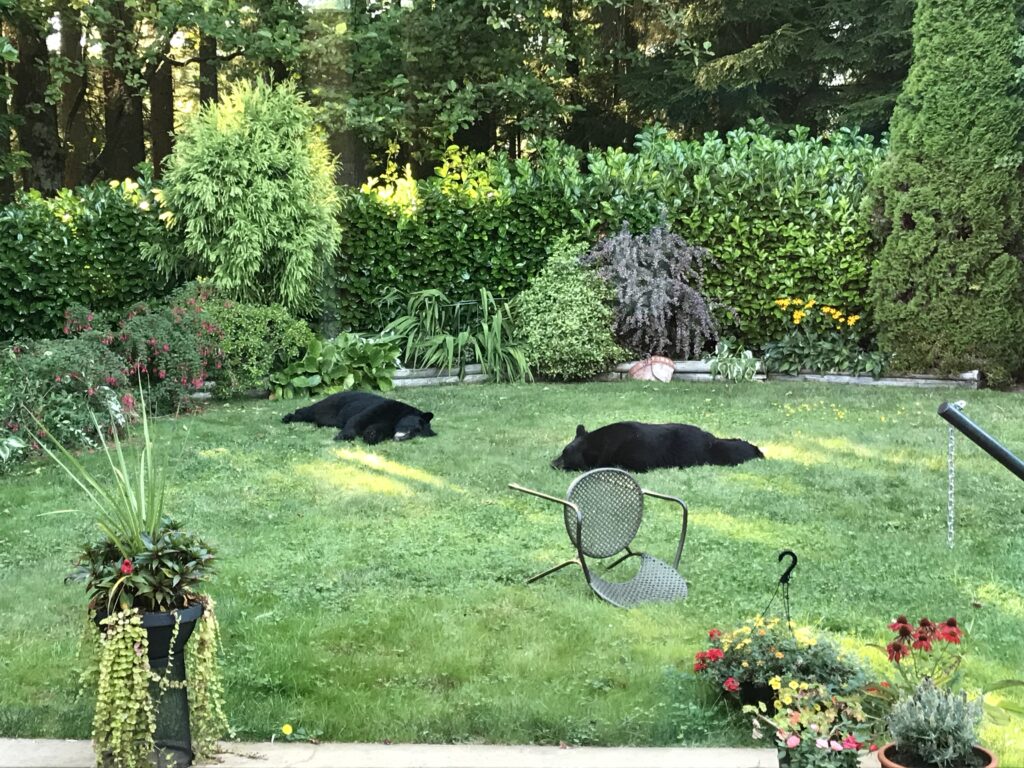
IF A BEAR IS RESTING IN THE NEIGHBOURHOOD
Increased human and dog activity in areas where bears live leaves little time for them to rest without interruption. Those of us living close to regional parks and busy trails should expect to see increased daytime sightings of bears sleeping at the back of properties or in trees. Often, residential areas are quieter than the forest during the day. Please help us to promote tolerance for black bears travelling through our communities and have patience when they take a moment to pause.
If a bear is sleeping on your property we advise letting them be, and moving them on with a firm voice from a safe place (deck or open window) once they stir. We do not need to be aggressive with them. Once the bear is alert, go to a safe place, make eye contact and use a firm tone to encourage the bear to move on. Black bears are calm and rarely run but if you are consistent and persistent, you can teach bears where they shouldn’t be, providing you are not tempting them with treats.
It is common for bears to be resting in trees around the community. It is rare for a bear to climb down a tree if people are close by. As it is their safe place, it is practically impossible to move a bear from a tree. It is important that people do not crowd the base of the tree, this traps the bear and adds further pressure to there lives. On very rare occasions, standing at the base of a tree could force the bear to feel defensive. If you see a bear in a tree, calmly back away and leave the area. Black bears often wait for a quiet opportunity or until darkness to climb down from a tree. Be prepared for them to be in the canopy for some time. Remember, the Conservation Officers do not relocate bears in British Columbia. Allow the bear space and time to safely climb down the tree and leave the community.
Injured bears are often forced to occupy areas closer to people for safety from dominant bears during their time of healing. Sadly, no medical care is available to bears above one year of age in British Columbia. The current options are no intervention or death. Bears are incredibly resilient, they can survive and heal from serious injuries. The NSBBS is not aware of a single incident where an injured bear has made contact with a person on the North Shore. The best thing we can do for injured bears is understand that they may need to spend more time resting close to the community for safety, give them lots of personal space and ensure there is no food for them around your home
If you meet a bear whilst walking in the neighbourhood or on your property: stay calm, speak calmly to the bear and slowly back away to give them space and an exit.
DAMAGE TO PROPERTY
Occasionally, bears travelling through our neighbourhoods cause property damage. Most often, residents report a bear-shaped hole in their fence, or sheds and garbage enclosures which have been damaged by a persistent bear.
Black bears may damage plastic or wooden sheds and enclosures. On almost every occasion this is reported to us, there was something highly odorous, such as: meat, fish, bones, meat grease, dirty diapers, pet food, bird seed or fish fertilizer inside. We advise storing these items inside your home or secure garage and not an enclosure unless it is reinforced with steel and locked. If a bear has accessed an enclosure, remove contents and leave clean and empty for as long as possible, we advise at least two weeks. Bears return to areas where they have found food and may visit for days.
On multiple occasions during the summer of 2020, residents informed us that bears had run through their fence as they rushed to get away from people and vehicles harassing them for photographs. To us, that damage is human-caused. Sometimes, bears climb a fence and unintentionally push a panel through with their back paws and some of our bears do just walk through fences.
Bears typically take the same routes until food sources in the area have been depleted. We advise residents who have had fencing or structures damaged by bears not to make any repairs for a few weeks. We’ve seen people fix the damage, only for it to happen again a day later. We understand that this is costly and time consuming and even the most tolerant people can lose their patience with bears. If a bear is reported to have damaged property they are at higher risk of being killed.
If you live in the District of North Vancouver and a bear has damaged your bear-resistant garbage or organics cart, contact the District for free repair.
RELOCATION IS NOT AN OPTION
A common misconception is that black bears in British Columbia are relocated from human occupied areas and taken to the forest. For bears in BC this is rarely an option and it is not the solution. For example, in June 2021, BC Conservation Officers killed 75 black bears – one bear was relocated.
The NSBBS supports relocating bears in rare situations, such as the young Burnaby bear who took a wrong turn on the tracks and found himself in Gastown. Any kind of human intervention creates opportunities for bears to be injured or killed. Moving a bear away to an unfamiliar area is incredibly stressful; relocated bears often return to areas they know, can be killed by other wildlife occupying the area or struggle to find food. Very often when bears are killed in residential areas, within days another bear takes their place. Moving bears is not the solution, bears are part of our wider community and we will always be neighbours. Learning more about their behaviour and acting on ways to reduce attracting bears to our homes, campsites and picnic tables is the solution.
BEAR DETERRENTS
We strongly advise against using bear bangers on the North Shore. Bear bangers are aggressive, easy to misuse and a fire hazard. Given the popularity of local trails with humans and dogs, using aggressive measures to push bears away from the community is not advised. Using a firm tone and making eye contact from a safe place (deck or window) if a bear is on your property is how we respectfully teach bears boundaries.
There is no substance that can be sprayed on items or around your home to deter bears. In fact, bears are curious and may be intrigued by scents, especially those that are off-putting to people. Bear spray is only to be used as an airborne deterrent, deployed at a bear that is approaching at close-range with intent. When bear spray settles to the ground, the oil and pepper become a bear attractant. If you deploy bear spray on your property, rise the area down with a hose and be prepared not to use the space for a couple of days.
Air horns and vehicle alarms work to deter some bears, but many are accustomed to loud noises. Our human voice is much more effective as bears are intelligent and understand tone.
DIVERSIONARY FEEDING
Planting fruit trees in the forest or intentionally leaving food for bears in any area on the North Shore is not the solution. Remember, feeding bears is illegal and though often well-intentioned, it almost always results with the bear being killed. With increasing numbers of people spending time in areas where bears live, diversionary feeding could create opportunities for those with ill intentions against bears, photographers who could pressure bears and increase bear activity in the area. Diversionary feeding would not support the vulnerable bears who typically spend more time close to residential areas, as the food would be consumed by dominant bears.
OTHER COMMONLY REPORTED ATTRACTANTS
FRIDGES, FREEZERS AND COOLERS
Bears can easily smell frozen food. Freezers, fridges and coolers should only be stored inside your home or secure garage or shed. These items are not made to be secure from bears, even if you have chains or padlocks. Every year, bears are killed for finding food from freezers and fridges outside homes on the North Shore.
PET FOOD
Bears do not see dogs and cats as a food source, but they are attracted to their highly odorous pet food. Always feed pets inside with the doors closed. Do not store pet treats close to doors or windows. Store excess pet food inside your home or secure garage or shed. Bears can be more persistent in their efforts to find pet food and may access an enclosure or garage if not sturdy and secure.
BBQ GRILLS
Bears like to lick dirty grills and grease traps. Clean the grill on a high heat and empty and clean the grease trap after each use. Never leave food unattended whilst cooking or enjoying food outside your home. Condiments and utensils should be stored inside your home when not in use.
CHICKENS
Backyard chickens and their feed are very strong bear attractants. Install and maintain electric fencing around coops and runs, year-round. Store feed inside your home or secure garage or shed. Free roaming chickens must be supervised at all times.
Permits, inspections and electric fencing may be mandatory. Visit your municipal website for specific instructions.
BEEHIVES
A beehive is irresistible to a bear. They love sweet honey and the protein found in bee larvae. If you have a beehive, please install and maintain electric fencing. Without electric fencing your hive is easily accessible to a bear. Check the fence at least twice a day and remember to maintain over the winter months.
VEHICLES
Bears have accessed vehicles on the North Shore. Bears that enter vehicles may cause significant damage, which your insurance might not cover. Keep vehicles free of all garbage and food. Bears may be enticed by everyday items such as chewing gum, empty coffee cups or granola bars. These inquisitive and intelligent animals can easily access vehicles that are not locked. Be sure to close all windows and lock all doors.
FOOD DELIVERIES
Avoid food sitting outside your home for any length of time. Bears are in most communities, even if you haven’t seen one. Within a few minutes, a bear’s nose could lead them to food at your door. Plan for items to be delivered when you are home or make arrangements with the delivery company or neighbours for items to be stored in a secure area.
BACKYARD COMPOST
Avoid adding eggs shells, grains, pasta, rice, meat, fish, bones, oil, fat, grease and dairy. A healthy compost requires equal portions of green (nitrogen-rich) and brown (carbon-rich) materials. Greens include fruit and vegetable scraps, fresh grass clippings, plant trimming and coffee grounds. Brown materials include fallen leaves, sawdust, torn egg carts and coffee filters. It is important to add oxygen to the compost every few days by turning.
RECYCLING
Unwashed and unsecured recycling can attract bears. Wash milk jugs, food containers, cans and jars. Rinse beverage bottles and cans. Store recyclables in a secure area until the morning of collection.
FISHPONDS
Bears love to fish in the wild and in the neighbourhood. Bears will drink from ponds and use them to cool off. Store fish food inside your home or secure garage or shed. Install and maintain electric fencing around fishponds to keep bears away.
TOYS/INFLATABLES/HOSES
Bears have been known to play with soccer balls and hoses and cool off in inflatable pools. Keep these items inside your garage or shed if you don’t want them to be popped.
POOLS/HOT TUBS
Occasionally, bears will take a dip in residential swimming pools and hot tubs. Such as this local bear in Blueridge.

